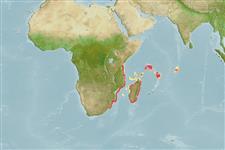Elasmobranchii (sharks and rays) >
Carcharhiniformes (Ground sharks) >
Proscylliidae (Finback catsharks)
Etymology: Eridacnis: Etymology not explained, possibly eri-, Greek intensive particle (i.e., very), and dakno (Gr.), bite, referring to “wide, angular” mouth of E. radcliffei (See ETYFish); sinuans: Latin for sinuous, probably referring to its slender body and/or long, ribbon-like caudal fin (See ETYFish).
More on author: Smith.
Environment: milieu / climate zone / depth range / distribution range
Ecology
Marine; bathydemersal; depth range 180 - 480 m (Ref. 244). Deep-water; 4°S - 30°S
Western Indian Ocean: confined to South Africa, Mozambique and Tanzania.
Length at first maturity / Size / Weight / Age
Maturity: Lm ?, range 37 - ? cm
Max length : 37.0 cm TL (female)
Short description
Identification keys | Morphology | Morphometrics
Dorsal spines (total): 0; Anal spines: 0. A slender, dwarf catshark with 2 equal-sized dorsal fins and a long tape-like caudal fin (Ref. 5578). Grey-brown in color (Ref. 5578).
Found on the upper continental slope and outer shelf (Ref. 244). Feeds on small bony fishes, crustaceans and cephalopods (Ref. 244). Ovoviviparous (Ref. 50449), with 2 young in a litter (Ref. 244). Geographic or bathymetric segregation of populations by sex probably occurs as most specimens taken off Natal were male (Ref. 244).
Ovoviviparous, embryos feed solely on yolk (Ref. 50449). Bears two young (Ref. 5578). Size at birth between 15 and 17 cm (Ref. 244).
Compagno, L.J.V., 1984. FAO Species Catalogue. Vol. 4. Sharks of the world. An annotated and illustrated catalogue of shark species known to date. Part 2 - Carcharhiniformes. FAO Fish. Synop. 125(4/2):251-655. Rome: FAO. (Ref. 244)
IUCN Red List Status (Ref. 130435: Version 2024-2)
Human uses
Fisheries: of no interest
Tools
Special reports
Download XML
Internet sources
Estimates based on models
Preferred temperature (Ref.
123201): 12.8 - 18.4, mean 15.3 °C (based on 18 cells).
Phylogenetic diversity index (Ref.
82804): PD
50 = 0.6328 [Uniqueness, from 0.5 = low to 2.0 = high].
Bayesian length-weight: a=0.00288 (0.00112 - 0.00741), b=3.15 (2.92 - 3.38), in cm total length, based on LWR estimates for this (Sub)family-body shape (Ref.
93245).
Trophic level (Ref.
69278): 4.2 ±0.58 se; based on food items.
Resilience (Ref.
120179): Very Low, minimum population doubling time more than 14 years (Fec=2).
Fishing Vulnerability (Ref.
59153): Low to moderate vulnerability (27 of 100).
